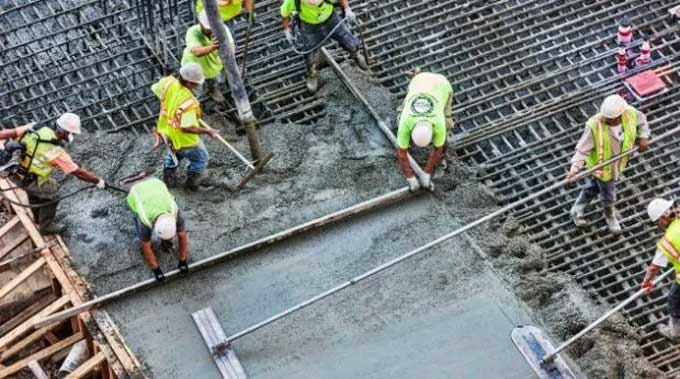
The RCC Slab Casting Process : A Step-by-step Guide
Concrete slabs made from reinforced cement are known as Reinforced Cement Concrete Slabs (RCCs). In the construction industry, it is the most important component. Structural components are made of RCC slabs. Support is provided by the columns and beams for the RCC slabs.
Concrete RCC slab construction requires great planning, accuracy, and proper sequencing in addition to great planning.
Equipment necessary for the casting process of RCC slabs
There are several pieces of equipment that will be necessary for the casting and checking process of RCC slabs. Some of the equipment are:
- CI Pipes
- Chute
- Vibrators
- Transit Mixtures
- Batching points
- Slump Tray
- Shovels
- Rubber Hammer
- Slump Cone
- Concrete Pump
- Power Float
Checks before concreting the Slabs
Prior to concreting reinforced concrete slabs, there are many checks to be performed:
Slab Formwork check
- Verify that the sleeves and supports of the formwork are properly fixed.
- Before concrete is placed on any formwork surfaces contacting concrete, shuttering oil and water need to be applied.
- Formwork or shutters made from damaged materials should not be used.
- The slab's projected top surface should be level, and level strips should be used if necessary.
Slab Reinforcement check
- Be sure to examine the spacing and cover of reinforcements, both vertically and horizontally.
- Verify and approve the fixing of reinforcements based on the approved drawings.
- Reinforcement bars' splices need to be tightened again if they are loose.
- Binding wires should have an inward bend at the free end.
- During concreting, ensure that reinforcements are adequately supported.
Other things to check
- Safety equipment and tools, such as safety helmets, safety shoes, goggles, gloves, and vests, should be used by workers.
- The entrance to the casting area should be equipped with safety devices and safety warnings.
- Make sure there is adequate lighting available when concrete is being poured at night.
Procedure of work
Reinforcing the Slab
In accordance with the approved drawing, it must be prepared in accordance with the BBS. The R/F binding and shifting must be undertaken immediately after shuttering. As long as the binding remains, the formwork will remain intact.
Concreting process
1. Construction joint: It may be possible to choose the construction joint and settle it before beginning the cementing or concreting process. For the principal building, two construction joints are desired. It is possible to clear out the extra construction joint if a massive breakdown occurs at the Batching plant. In construction joints, the area should be approximately 33% traversed.
In order to reinforce successive layers of concrete impeccably, the construction joint should be straight and have an L-shaped profile.
It may be necessary to roughen the construction joint, remove all laitance from it, and use thick slurry before new concreting begins.
2. The placement and the production of concrete: For concrete work to begin, there must be an adequate supply of materials. To ensure that concreting is not halted due to materials shortages, it must be properly monitored by the store or purchase department.
Pre-checking of the plant, machinery, and equipment is completed before they are put into operation.
The batching plant produces concrete of grade M-25, which is then directly pumped to the concrete placement site via a long pipeline. Beginning with grid A, the pouring sequence should continue in the direction of the construction joint.
Concrete grade M-40 should be used for the offset adjacent to the column since adjacent concrete grade M-25 should be used for the column. Dimensions of the offset must be provided by PMC.
There must be proper walkways and platforms created so that the pipeline and manpower can be supported and upheld without being put under immediate pressure. At the time of casting, many carpenters and supervisors need to thoroughly inspect and supervise the behaviour of the supports below the slab.
To provide further support in the event of a failure or breakdown of the supports, extra props must also be stacked down below the slab.
To get more details, watch the following video tutorial.
Video Source: Civil Tech Constructions
3. Finishing the concrete surface: Whenever necessary, the Quality Engineer shall fill out the concrete pour card and submit it to the Engineer, along with concrete delivery notes. Smooth finish surfaces can be achieved by using the power float.
To prevent plants and types of machinery from damaging the concrete, barricades should be placed around the casted area or member.
Curing
Curing must begin as soon as the concrete is laid down after thumb setting. It is essential to cover the concrete thoroughly with plastic during the hardening process to reduce humidity and moisture evaporation and, thus cracks are formed. During the casting of flat surfaces, cracks are evident because of the inheriting qualities of concrete.
These cracks are an inherited trait of concrete, and they particularly manifest themselves during the casting of flat surfaces. By ponding and piling water for a minimum of 7 days, the final curing is required.


